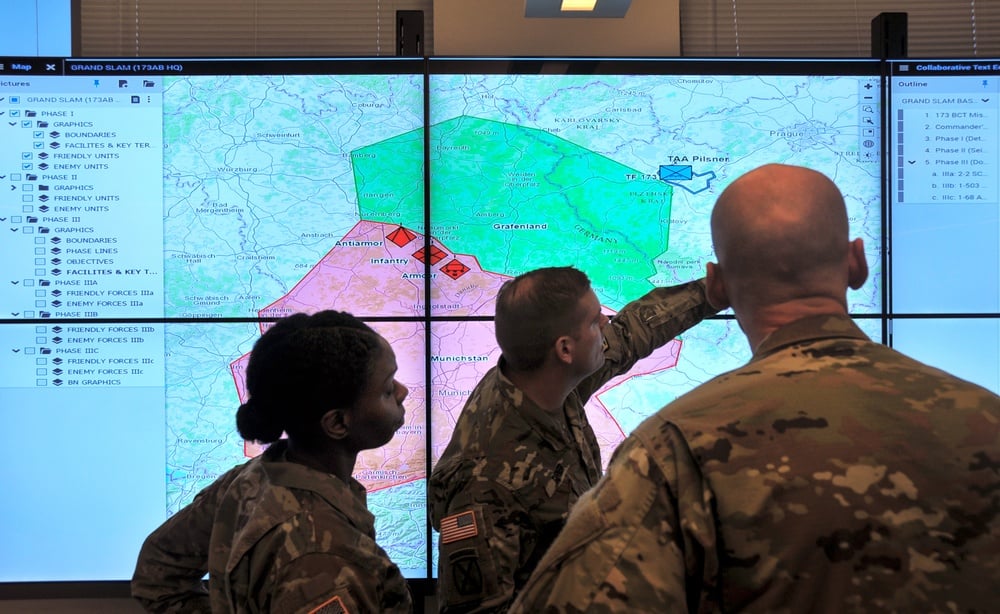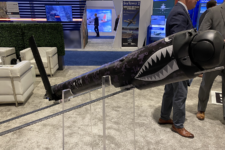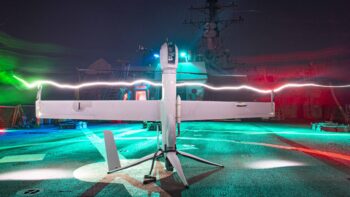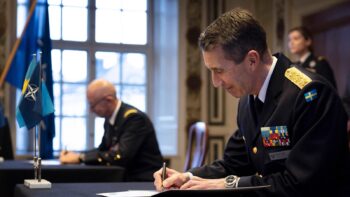
Soldiers demonstrate the Command Post Computing Environment prototype at Aberdeen Proving Ground in May. (U.S. Army photo by Dan Lafontaine, PEO C3T)
WASHINGTON — By October this year the Army will have officially restructured its main offices responsible for the development and acceleration of its enterprise and tactical network and cyber operations, in an effort to streamline the service’s current set up.
As it was, the service’s different network and cyber efforts were spread across three program executive offices (PEOs). But under the restructure, which was announced in May, several organizations will be shuffled and redistributed under the umbrella PEOs for command, control, communications-tactical (C3T), intelligence, electronic warfare and sensors (IEW&S) and enterprise information systems (EIS).
“To achieve digital transformation and better support delivery of a unified network” the assistant secretary for the Army of acquisition, logistics and technology is “optimizing PEOs and making changes to demonstrate agility and synergy,” Paul Mehney, a spokesman for PEO C3T told Breaking Defense in a statement.
Mehney said that no current contracts, awards, jobs or physical moves are being affected by the PEOs restructuring. But the change could pay dividends with better organizational lines and focus areas — or at least, the Army hopes it does.
More details of how this will all work might come during the upcoming AFCEA TechNet Augusta conference, but for now, here’s the breakdown of what the restructure will look like:
PEO C3T
PEO C3T, the office responsible for modernizing the Army’s enterprise and tactical network, will absorb several organizations from PEO EIS. Mark Kitz was announced as the new chief of PEO C3T in June, and most recently led PEO IEW&S.
Among the biggest additions to C3T is the transition, effective Oct. 1, of PEO EIS’s integrated enterprise network (IEN) portfolio. IEN is responsible for more than 100 projects supporting everything from “worldwide strategic satellite communications and wideband control systems to long-haul terrestrial microwave and fiber optic communications systems to technical control facilities, combat service support communications systems and critical power infrastructure,” according to the Army.
IEN includes four major programs: global enterprise network modernization – Americas; global enterprise network modernization – OCONUS; base emergency communications system; and wideband enterprise satellite systems. The office has an annual budget of more than $689 million, according to the Army.
PEO EIS’s enterprise – identity, credential and access management (E-ICAM) product office, which was established just this January, will also move to PEO C3T. Per the Army, the office works to “establish a global, scalable, robust capability leveraging a single set of authoritative identity data to grant access to Army IT resources at the point of need, regardless of location, and set the foundations for the Zero Trust Architecture Framework.”
One office splitting into two is PEO EIS’s defensive cyber operations (DCO) portfolio. PEO C3T will take over the allied information technology program office, currently part of DCO, which provides command, control, communications, cyber and intelligence support to partner nations.
By moving those offices out from under the enterprise tech umbrella to one dealing with tactical applications, Mehney said the Army “will be better able to deliver persistent network connectivity and capabilities to the edge.
“Technical design and integration of persistent and episodic networks will be realized, along with the ability to seek user feedback across the unified network portfolio,” he said. “Additionally, identity and credential access management (ICAM) will be managed as one singular effort, moving forward across the unified Network.”
PEO IEW&S
PEO IEW&S will now house all of the Army’s cyber efforts. This includes taking the rest of PEO EIS’s DCO portfolio: the technology application office, cyber analytics and detection program and cyber platforms and systems program, PEO IEW&S Spokeswoman Justin Ruggio told Breaking Defense.
“The move of PM DCO enables the ability to protect (defend) our networks, exploit (offensive) cyberspace, and conduct cyber effects for multi domain dominance all from one PEO,” Ruggio said in a statement. “It enables a natural synergy of mission and stakeholders. Each of these missions will remain as full product management offices and will not result in any movement of workforces.”
PEO IEW&S just last month also established the program management office for cyber and space (PM C&S), a new office focused on cyber, information warfare and tactical space missions, led by Christopher Green. He previously served as the product manager for the joint battle command platform in PEO C3T and as deputy project manager for PEO EIS’s defensive cyber operations.
“The establishment of PM C&S will bolster support to the Army Cyber Community and is the latest step in the Army’s recognition that these contributions to the Joint cyber warfighting operations extends beyond Army Cyber Command to the Army Acquisition community,” according to the Army. “In the next six to 12 months, PM C&S will continue focusing on recruitment of new talent, while still supporting key stakeholders.
PEO IES And Future Reshuffles
As for what’s left in PEO EIS, the program office’s website lists areas besides DCO for which it’s responsible, including providing “the Army’s IT infrastructure by equipping soldiers with technology” and several data and logistics-related programs. Notably, a spokesperson confirmed that EIS will not be adding any new programs to their portfolio at this time.
Ross Guckert, who leads PEO EIS, told Breaking Defense his office will now be more focused “on business systems and enterprise services.
“It will be difficult to lose some key partners that have been instrumental in modernizing Army camps, posts, and stations, and delivering defensive-cyber capabilities to stay ahead of the threat, but I know they are going to be in good hands,” he said.
More Army offices could follow this type of reorganization in the future. Young Bang, principal deputy assistant secretary of the Army for acquisition, logistics and technology, said in May that unmanned aerial vehicles, an area currently spread across offices like PEO aviation and PEO soldier, could be ripe for its own shakeup.
“So I do think that we need to get a little bit better… I do think UAVs, for example, we probably need to have some more deliberate thought and planning around that,” he said then. “And that may necessitate some shifts of other things… But what we want to do is figure out what makes the most sense for what we’re trying to do now and then be flexible and look at that.”






















